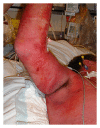Rapidly developing toxic epidermal necrolysis
- PMID: 24069541
- PMCID: PMC3771460
- DOI: 10.1155/2013/985951
Rapidly developing toxic epidermal necrolysis
Abstract
Severe cutaneous reactions with potentially fatal outcomes can have many different causes. The Stevens-Johnson syndrome (SJS) and toxic epidermal necrolysis (TEN) are rare. They are characterized by a low incidence but high mortality, and drugs are most commonly implicated. Urgent active therapy is required. Prompt recognition and withdrawal of suspect drug and rapid intervention can result in favourable outcome. No further international guidelines for treatment exist, and much of the treatment relies on old or experimental concepts with no scientific evidence. We report on a 54-year-old man experiencing rapidly developing drug-induced severe TEN and presented multiorgan failure involving the respiratory and circulatory system, coagulopathy, and renal insufficiency. Detachment counted 30% of total body surface area (TBSA). SCORTEN = 5, indicating a mortality rate >90%. The patient was sedated and mechanically ventilated, supported with fluids and inotropes to maintain a stable circulation. Component therapy was guided by thromboelastography (TEG). The patient received plasmapheresis, and shock reversal treatment was initiated. He was transferred to a specialized intensive care burn unit within 24 hours from admittance. The initial care was continued, and hemodialysis was started. Pulmonary, circulatory, and renal sequelae resolved with intensive care, and re-epithelialization progressed slowly. The patient was discharged home on hospital day 19.
Figures
Similar articles
-
Improving mortality outcomes of Stevens Johnson syndrome/toxic epidermal necrolysis: A regional burns centre experience.Burns. 2018 May;44(3):603-611. doi: 10.1016/j.burns.2017.09.015. Epub 2017 Oct 10. Burns. 2018. PMID: 29029855
-
Treatment of toxic epidermal necrolysis by a multidisciplinary team. A review of literature and treatment results.Burns. 2018 Jun;44(4):807-815. doi: 10.1016/j.burns.2017.10.022. Epub 2018 Apr 4. Burns. 2018. PMID: 29627131 Review.
-
Nine years of a single referral center management of Stevens-Johnson syndrome and toxic epidermal necrolysis (Lyell's syndrome).Cutan Ocul Toxicol. 2017 Jun;36(2):163-168. doi: 10.1080/15569527.2016.1218501. Epub 2016 Aug 22. Cutan Ocul Toxicol. 2017. PMID: 27487073
-
Toxic epidermal necrolysis and Stevens-Johnson syndrome/toxic epidermal necrolysis overlap in pediatric patients with a focus on newer antiepileptic drugs: A 25-year retrospective study at a single tertiary care center.Pediatr Dermatol. 2021 Jul;38(4):812-818. doi: 10.1111/pde.14598. Epub 2021 May 31. Pediatr Dermatol. 2021. PMID: 34060145
-
Toxic epidermal necrolysis (Lyell's disease).Burns. 2010 Mar;36(2):152-63. doi: 10.1016/j.burns.2009.06.213. Epub 2009 Sep 18. Burns. 2010. PMID: 19766401 Review.
Cited by
-
Topical moxifloxacin-induced toxic epidermal necrolysis and Stevens-Johnson syndrome.J Postgrad Med. 2019 Apr-Jun;65(2):125-126. doi: 10.4103/jpgm.JPGM_535_18. J Postgrad Med. 2019. PMID: 31036782 Free PMC article. No abstract available.
-
Updates in the pathogenesis of SJS/TEN.Allergol Int. 2025 Jul;74(3):361-371. doi: 10.1016/j.alit.2025.05.002. Epub 2025 Jun 4. Allergol Int. 2025. PMID: 40473510 Free PMC article. Review.
-
Update on Stevens-Johnson Syndrome and Toxic Epidermal Necrolysis: Diagnosis and Management.Am J Clin Dermatol. 2024 Nov;25(6):891-908. doi: 10.1007/s40257-024-00889-6. Epub 2024 Sep 15. Am J Clin Dermatol. 2024. PMID: 39278968 Free PMC article. Review.
References
-
- Fritsch PO, Sidoroff A. Drug-induced Stevens-Johnson syndrome/toxic epidermal necrolysis. The American Journal of Clinical Dermatology. 2000;1(6):349–360. - PubMed
-
- Palmieri TL, Greenhalgh DG, Saffle JR, et al. A multicenter review of toxic epidermal necrolysis treated in U.S. burn centers at the end of the twentieth century. Journal of Burn Care and Rehabilitation. 2002;23(2):87–96. - PubMed
-
- Pereira FA, Mudgil AV, Rosmarin DM. Toxic epidermal necrolysis. Journal of the American Academy of Dermatology. 2007;56(2):181–200. - PubMed
LinkOut - more resources
Full Text Sources
Other Literature Sources


